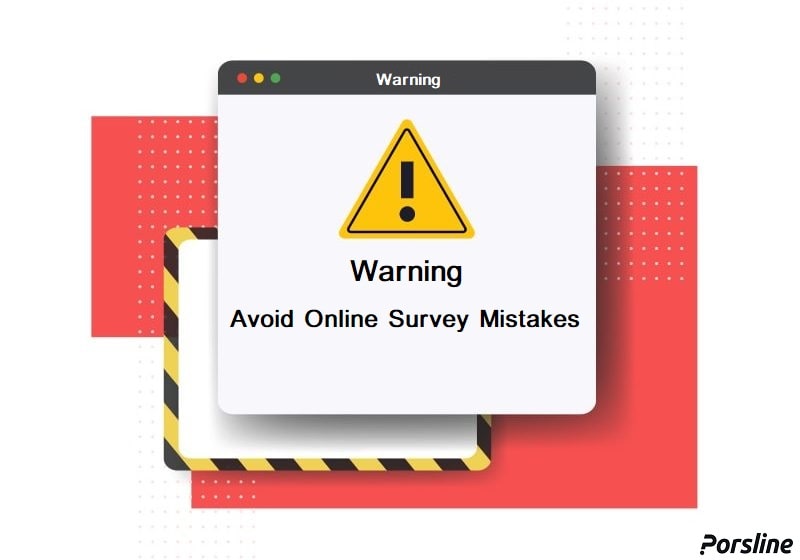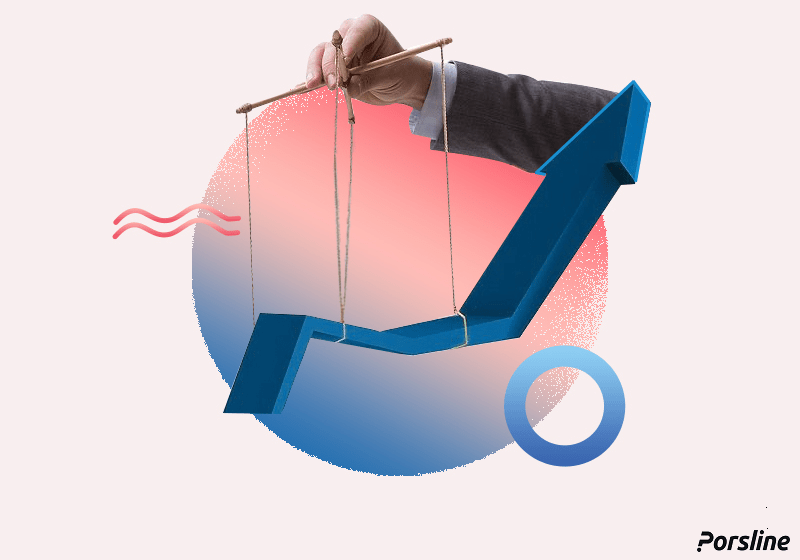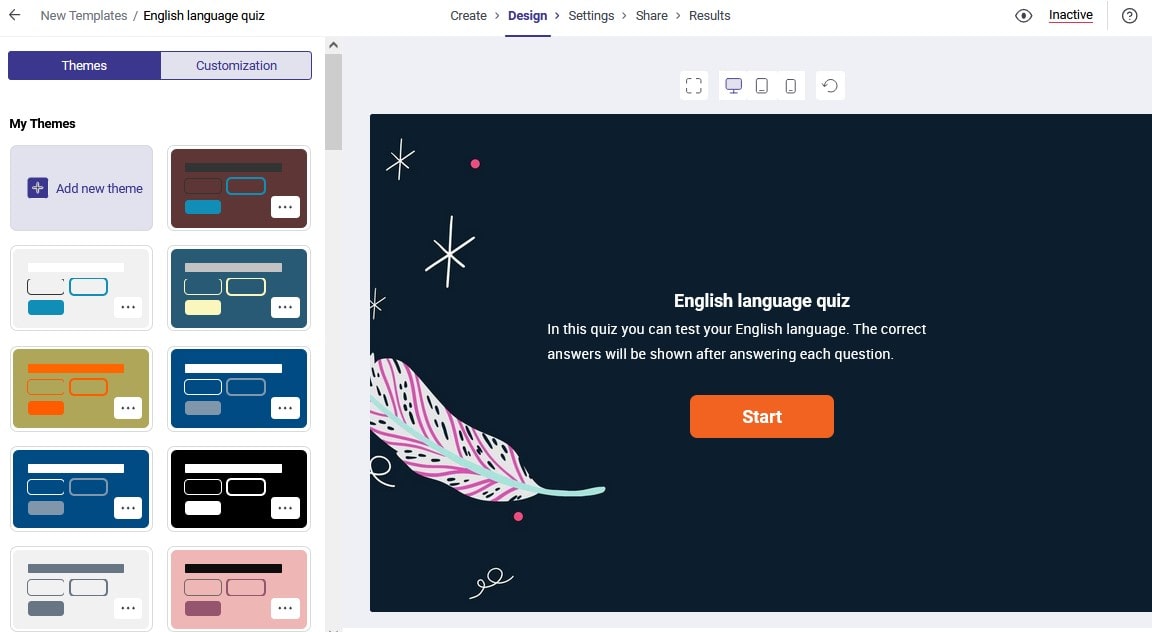What is organizational change culture and why should all managers be ready for change in their organization?

Currently, companies that want to adapt to new conditions and to be more creative face many challenges. One of these challenges is realizing and creating organizational change culture among employees.
In a published study, Christian Anacleto has concluded that if we implement the organizational change steps correctly, we can better interact with employees and engage them in a positive way along with reducing the costs of change in the core of the business.
Culture is formed among individuals. It can be simply said that culture means common thinking, beliefs and behavior of a number of people who work or live together. With this primarily definition, we can say that organizational culture is composed of the combination of two words; culture and organization.
The culture of any organization is formed from the common points of thinking, views and behavior of the individuals within the organization. Although many organizations try to impose a certain culture in the organization, it should be believed that cultures are usually formed through the combination of views from top to bottom and vice versa in organizations.
The culture of each organization differs from one another. It can be said that it is not possible to find two organizations with the same organizational culture (even if they have the same intellectual approach). But why is organizational culture important? It seems that organizations that have a correct and appropriate organizational culture get more attention, and more people are interested in working in such organizations.
It is interesting to know that, apart from the culture being different in different organizations, the culture of different parts of an organization are not the same, too. For example, the culture of the discipline and security department of an organization might be serious and strict, while the culture of the public relations department of the same organization might be friendly.
Of course, in addition to the general view of cultures and their classification, there are scientific models and more accurate classifications of organizational culture that we will be clarified in this post.
Why should we create a change culture in the organization?
The culture that governs an organization is usually formed over years. Every person, as an effective factor, can have an impact on the culture of the organization, no matter how small.
Therefore, incurring change in the organization is not an easy task. Suppose that a person has not been paying attention to the entry and exit times for many years. If you want to set regular working hours for the employees of this organization, you will probably face many objections.
Change is always difficult, because people are usually used to the current state. In fact, leaving a safe place and examining new situation and changing to achieve new goals is not usually an easy task. If you wish to make a change in the organization, you should try to create a culture for that change.
Building culture usually starts with educating and giving information. Explaining the benefits and positive points of new decisions can help build a new culture. It would be simpler to make changes to only a small part of the organization, but if the change is to involve the whole organization, the steps will be more complex.
Creating a new culture requires knowing the current culture of the organization. The more accurate you know about the current culture of the organization, the better you can be prepared for the culture change. Culture is a collective concept, and it is not possible to reach the desired result by only changing one or a few persons.
Change in the organization needs leadership and management. Every change needs a person who accepts the required change with all his/her heart. If you wish to start creating a culture of organizational change in the organization, you need a person or a group of people who can perform the task of change leadership and management in the organization well.
What is McKinsey 7S model and how does it help create a culture of organizational change?
Although leadership and management are used in the same meaning in many cases, it should be said that leadership refers more to gaining knowledge and insight about the current situation and accurate planning for the future according to circumstances. This is while management focuses more on implementing changes and how to make it.
One of the models used for accurate evaluation of organizations is McKinsey 7S model. This model has two main parts: hard and soft elements. The hard part includes the Structure, Strategy and Systems, while the soft part includes the Skills, Staff and Style. The Shared values, as the seventh part, are shared between the two parts of this model.
This model can be used to study, establish and explain organizational culture. Although the 7S model was not directly designed to formulate organizational culture, it is possible to have an accurate view of the organization by using its parts.
It can be simply said that the culture of the organization consists of a combination of the structure, strategy, systems, skills, staff, style and shared values. The culture of any organization can be evaluated with these seven elements. We will have an overview on those seven elements of McKinsey model in the following.
You can use McKinsey model if you wish to prepare the organization for change and want to create a culture of organizational change. To create a good and appropriate culture for your organization, you should pay attention to the following points:
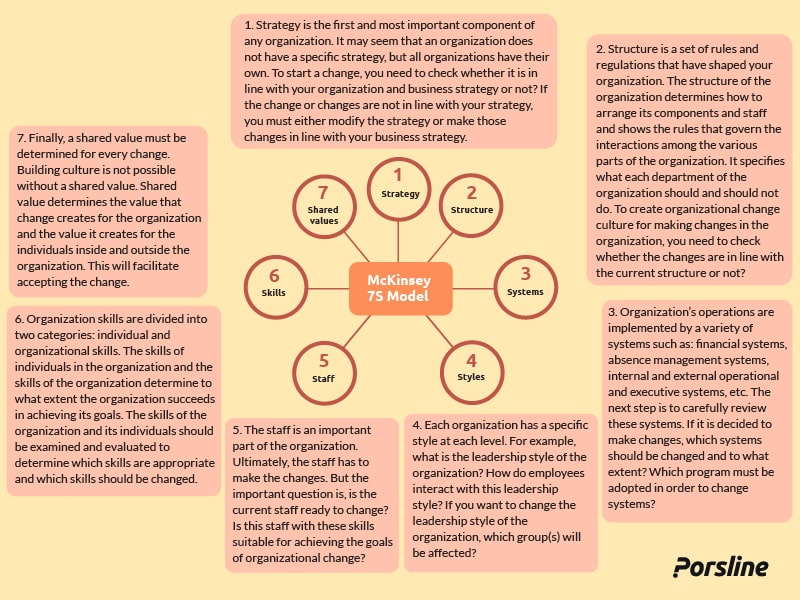
- Strategy: Strategy is the first and most important component of any organization. It may seem that an organization does not have a specific strategy, but all organizations have their own. To start a change, you need to check whether the change is in line with your organization and business strategy or not? If the change or changes are not in line with your strategy, you must change the strategy first. The other way is to make the changes in line with your business strategy.
- Structure: Structure is a set of rules and regulations that shaped your organization. The structure of the organization determines how to arrange its components and staff and shows the rules that govern the interactions among the various parts of the organization. It specifies what each department of the organization should and should not do. To create organizational change culture for making changes in the organization, you need to check whether the changes are in line with the current structure or not?
- Systems: Organization’s operations are implemented by a variety of systems such as: financial systems, absence management systems, internal and external operational and executive systems, etc. The next step is to carefully review the systems. If it is decided to make changes, which systems should be changed and to what extent? What is the program that must be worked on in order to change systems?
- Styles: Each organization has a specific style at each level. For example, what is the leadership style of the organization? How do employees react with this leadership style? If you want to change the leadership style of the organization, what group or groups will be affected?
- Staff: The staff is an important part of the organization. Ultimately, the staff has to make the changes. But the important question is, is the current staff ready to change? Is this staff with these skills suitable for achieving the goals of organizational change?
- Skills: Organization skills are divided into two categories: individual and organizational. The skills of individuals in the organization and the skills of the organization determine to what extent the organization succeeds in achieving its goals. The skills of the organization and its individuals should be examined and evaluated to determine which skills are appropriate and which skills should be changed.
- Shared values: Finally, a shared value must be determined for every change. Building culture is not possible without a shared value. Shared value determines the value that change creates for the organization and the value it creates for the individuals inside and outside the organization. This will ease accepting change.
How to establish organizational change culture?
There are various methods and models to measure the readiness of the individuals in an organization for change. ADKAR model is one of the most standardized models for measuring readiness for change. This model consists of five keywords: Awareness, Desire, Knowledge, Ability, and Reinforcement.
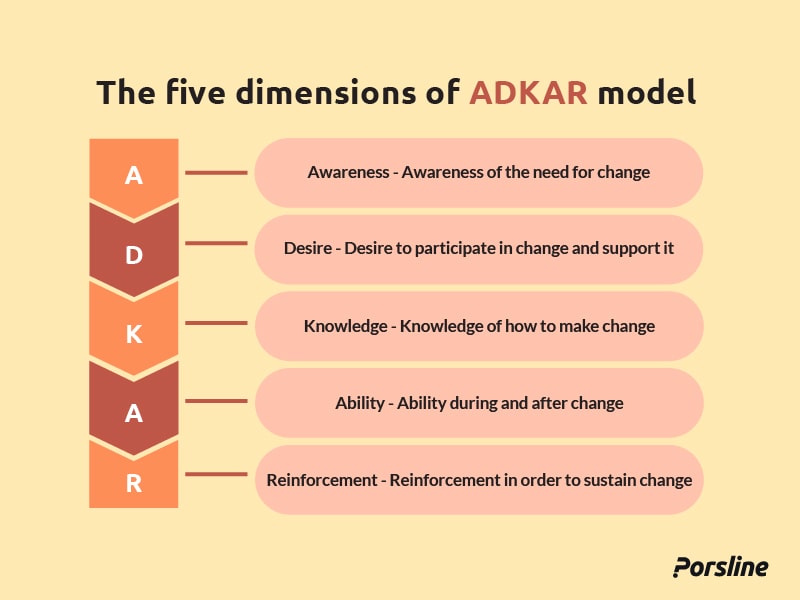
To learn more about ADKAR model for change management and how it helps measuring the organizational change culture, we will study its sections:
- Awareness: In this section, people’s awareness of change is evaluated. This section examines four key points about change.
-
- What are the effective and ineffective changes for the business?
- What questions are important regarding change?
- Each change usually starts with identifying a specific problem. What are the current problems in the organization?
- Prioritizing and focusing on the most important reasons for change.
- Desire: After raising awareness, employees should be induced to change. The following points should be considered to create the desire to change.
-
- Talking about the benefits of agile change.
- Accurate review of the risks and problems that hinder change.
- Taking steps to change.
- Examining current concerns for change.
- Knowledge: How to change is examined in this stage.
-
- Learning new skills needed for change.
- Learning team thinking for change.
- Learning to schedule appointments and time for change.
- Learning to share knowledge.
- Setting goals with specific reasons for change.
- Ability: In the ability stage, we determine what capabilities are required for change.
-
- Forming a legal framework for change.
- Practicing the basics needed for change.
- Starting from small things.
- Doing nothing secretly so that everyone can upgrade their abilities.
- Adjusting processes to align with agile changes.
- Reinforcement: Every change usually encounters resistance from the organization’s members. Reinforcements can be used to engage more people.
-
- Introducing agile managers as champions of change.
- Sharing the individuals’ experiences in agile change with other individuals in the organization.
- Learning from mistakes. In fact, you should let people make mistakes and learn from them.
The stages of ADKAR model clarify that for making a change, an organization must to be prepared in five general stages. Suppose you want to make a small or big change in the organization. The awareness of the organization members is the first and most important matter that must be considered.
The next issue is whether the individuals in the organization are willing to change or not. After that, you must determine the extent of people’s knowledge of change. Do they know what this change is? What are its effects on the organization or business? and many other questions. In the next stage, you should check whether people have the necessary abilities to change or not. Finally, you should try to add excitement and motivation elements such as rewards and appreciation so that the organizational change culture is formed in people to become more and more interested and less resistant to change.
But you need a survey to check the readiness of the organization and its individuals for change according to these five aspects. You need to submit ADKAR survey form to all the employees involved in the change and study its results.
Conclusion
Organizations and business companies go through various stages with time until they reach a stable structure. Therefore, small or big changes in the formed structure and turning this into organizational culture are not easy tasks. It is easy to evaluate the readiness of individuals to change using various models designed for organizational change and organizational change culture. Furthermore, by using these models, it is possible to plan the implementation path of the organizational changes and build an organizational change culture.
Using advanced online survey tools such as Porsline can help speed up the study and analysis of the organization’s readiness for change. Building and publishing an online survey is one of the most important Porsline services, which can be used in designing the ADKAR survey form.


